Tip and Run raids and HAA Battery NH7
Posted: 18 October 2011 21:26
The Luftwaffe began mounting 'Tip and Run' raids on the English south coast towns in 1941. Some documents, fieldwork and an impromptu air display provide some interesting insights as we follow an anti-aircraft battery from construction through its first engagements.
A tip and run raid involved a small number of fighters (two or three in most cases, but sometimes 20+) flying just above sea level towards the coast to avoid detection by radar, suddenly crossing the coast, dropping bombs, machine-gunning targets of opportunity and making off before the defences had time to react.
A few weeks back I had an unexpected tip and run experience. I was standing on the clifftops of Seaford Head looking for an anti-aircraft battery when I heard a familiar droning noise. I was awestruck as I realised that the four black specks coming in from the east were aircraft powered by Merlin engines.
Within a matter of seconds a flight of two Spitfires followed by a Hurricane and a Messerschmitt Me109 roared past me at an altitude not significantly higher than the cliffs I was standing on.
As the aircraft cruised past at a relaxed pace I was left fumbling with my camera, but I managed to rattle off a burst of four photographs as they followed the coastline towards an airshow a few miles away.

Not very good photos, but I was taken by surprise. Now think how many pictures I might have taken if these aircraft were flying towards me at zero feet and not presenting a slow, broadside target? These were the sorts of problems faced by anti-aircraft gunners who, by the very nature of tip and run, had little or no warning.
The documents describe numerous attacks where the raiders got away unharmed, even when the defences did react in time. However,I did come across a piece of sensational shooting from a Heavy Anti-Aircraft (HAA) Battery at Friar's Bay, Peacehaven.
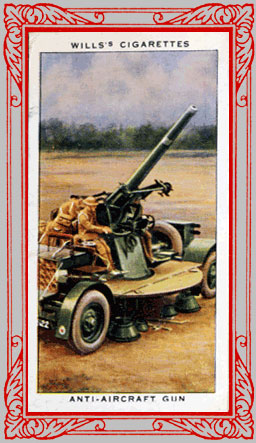
Establishment and initial phase of construction of the battery
It was in 1939 that Newhaven became a Gun Defended Area with the establishment of three batteries of 3-inch guns of the type illustrated in the famous 1938 cigarette cards at right.
One such battery of two guns was established at Friar's Bay as part of the Newhaven GDA. The 3-inch gun was a First World War design, and was soldiering on until the superior 3.7-inch could replace it in service.
The 3.7-inch gun was made in two basic varieties; a mobile version with wheels and a static version designed to be bolted onto a concrete holdfast, the latter being the cheapest and easiest version to manufacture. Experience (particularly during the V1 flying bomb attacks of 1944) showed however, that mobile guns were by far the best option.
The increased threat of air attack on coastal towns lead to them being classified as VPs, or Vulnerable Points and the anti-aircraft defences bolstered.
A new wave of battery construction in Newhaven saw the introduction of the 3.7-inch gun. Friar's Bay was to have a four-gun battery, assigned the serial number NH7. This was built away from the original 3-inch guns.
A quick timeline compiled from war diaries describes the battery's history:
31 March - construction begins on batteries in the Newhaven area.
6 April - The first battery personnel arrive at NH7.
8 April - 4 mobile 3.7" guns arrive at NH7 until static guns can be emplaced.
14 May - Four static 3.7" holdfasts arrive at NH7.
Just six days after the static holdfasts arrived, the guns claimed their first 'kill' during a hit and run raid.
NH7's first successful engagement
On 20 May, the War Diary gives us the following report:
ENEMY ACTIVITY1104 to 1110 hours two ME 109Fs made low level bombing attack on some barges and two Motor Launches about two and a half miles off NEWHAVEN. No damage or casualties.
One aircraft engaged by light Naval fire...was seen to be hit and crash landed on land.
The other aircraft was engaged by three HAA guns at NH7 who fired three rounds HE. The aircraft was then travelling out to sea at a range of 8-10,000 yards at a height of 50ft.
Gun Control was used and one burst was seen on the tail of plane which was observed by the crews of the Motor Launches to dive into the sea.
The photo below shows the general scene from the battery; the spot at right is the approximate point at which the Me109 was hit.
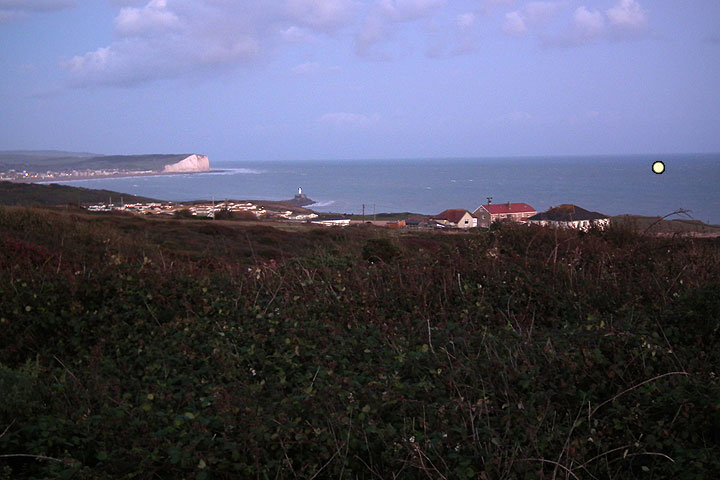
The raiders' downfall was perhaps their engagement of shipping as a target of opportunity; the report states that this was unsuccessful in itself, but it's likely that this action alerted NH7 to the Messerschmitts.
No prior warning was received of the attack; the Me109s had obviously flown under the radar screen, and so the instruments such as GL (Gun-Layer) radar sets that gun batteries used to guide predicted fire were of no use.
However, it seems that the Gun Position Officer (GPO) took matters into his own hands. The height finder was used to get the range of the ships under attack and the bearing calculated. The diary again:
GPO estimated that, on turning away after the attack, enemy aircraft would be near limit range when bursts occurred...Nos 1 and 2 guns fired simultaneously, followed by No.4 gun. The burst occurred low above sea level in the line of sight after which the aircraft could not be seen.
The Motor Launch crews' testimony allowed confirmation of the kill being awarded to NH7. The graphic below indicates the difficulty of the shot; this was at a time when HAA fire at unseen night bombers was expending an average of 2,600 3.7-inch rounds for each raider destroyed. To bring down an aircraft (albeit a seen target) for just three rounds was indeed good shooting!
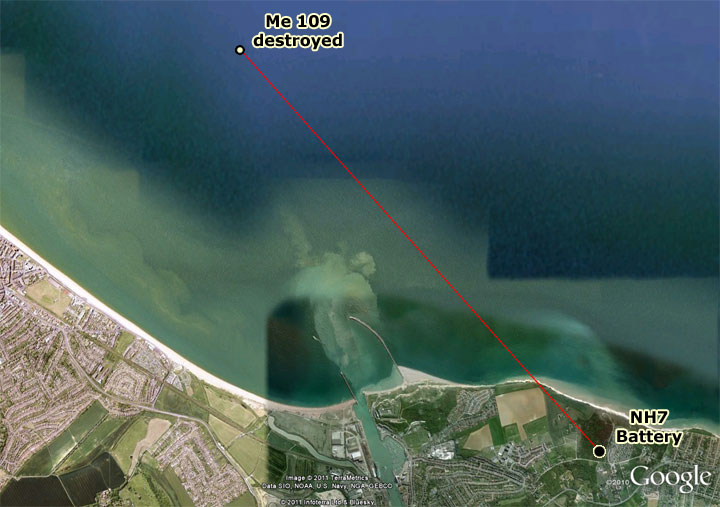
Subsequent engagements
NH7 was firing again within days, but at a 'friendly' target this time; a barrage balloon that had broken loose from a ship was brought down with small arms fire (again, just three rounds!)
At the end of May an exercise was carried out whereby the Home Guard "attacked" the battery and by June 1st, another engagement. Four rounds were fired at 2 ME 109s at 2000 ft, but without any known effect.
There appears to have been no further excitement until 28 July when 5 rounds were fired at two low-flying aircraft attacking shipping two miles offshore:
ENEMY ACTIVITYAt 1535 hrs without any previous warning two Me 109Fs approached Newhaven Harbour flying from the SSW coming out of the sun at 200ft. Two small ships were attacked with machine-gun fire and two HE bombs were dropped in the sea causing very slight damage to the ships. After circling the ships the enemy aircraft went away to the south, climbing rapidly. Enemy aircraft were engaged by HAA site NH7 and LAA site, but no hits were observed.
At this time, the diary records that construction of the Newhaven batteries was nearing completion, with finishing touches to Command Posts and camouflage on gun positions being applied.
August saw two engagements, the first of which appears quite similar to the May 20 and July 28 incidents:
At 10:10 hrs HAA Site NH7 saw explosion in sea off Newhaven. No ship visible. Immediately after 2 aircraft believed Me 109s were seen at 7-8 thousand yards in haze at sea level and engaged by NH7. No claims. Firing stopped when Spitfire intercepted from east. No prior warning.
The extract above, from the Brigade War Diary, states that no claims were made, but the Regimental diary states that one enemy aircraft was believed damaged; this belief was obviously not strong enough to be accredited with any hits. 13 rounds were fired by NH7 in total, which was a lot more than the guns had had time to loose off on previous engagements.
NH7 was again in action just over a week later, when some night raiders were engaged without effect as flares, incendiaries and HE bombs fell in the Seaford area. The HAA gun batteries along the coast at Brighton and Shoreham had better luck that night, sharing a Heinkel He 111 between them, while a Bofors site claimed a Junkers Ju 88 destroyed.
On 24 August, NH7 was one of seven HAA batteries to engage two high-flying aircraft, believed to be Ju 88s.
Two weeks later, NH7 fired two indicator rounds at a pair of high-flying aircraft to help draw the attention of night fighters to the raiders. The engagement of 2 FW 190s on 24 September marks the last hostile activity in the first six months of NH7's life. Construction of hutting and weather-proofing of the site continued throughout September. However, in 1944 the Newhaven HAA batteries were substantially rebuilt.
Surviving evidence of the Friar's Bay HAA Battery
A trip to the site revealed that very little of the battery remains; the site is totally overgrown with gorse bushes and a mobile home park occupies a substantial area.
Shown below is an interesting structure. It comprises a square shelter built of concrete breeze blocks with an extension of elephant iron. The function of this structure is unclear; it might have been a war shelter for a gun crew on standby, or perhaps it was for stores.
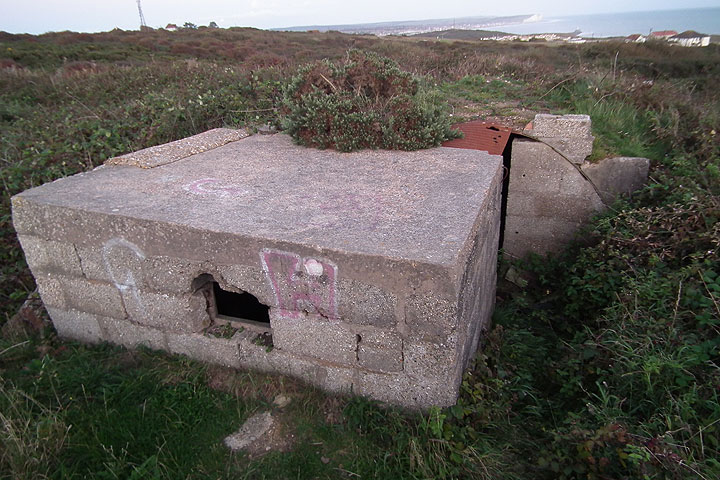
Of particular interest inside the elephant shelter is the presence of wartime paintwork; the standard scheme of dark green stripe around the lower walls, a dark border and cream covering the rest.
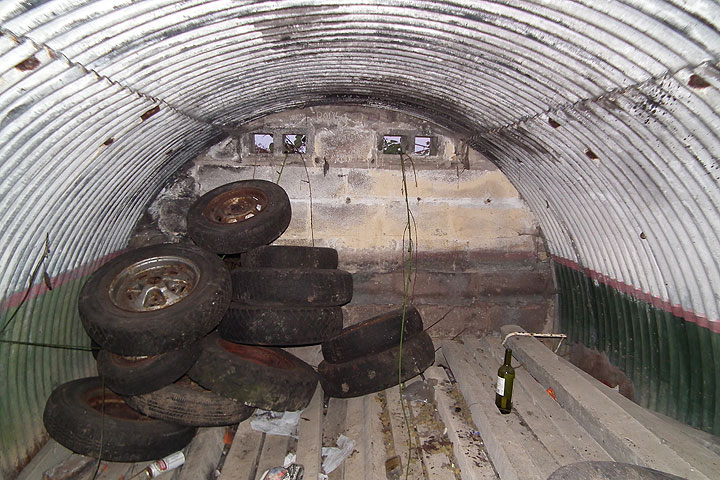
The concrete breeze block is the predominant material here and despite the fact that some walls still stand after nearly 70 years, the construction looks rough and very shoddy in places.
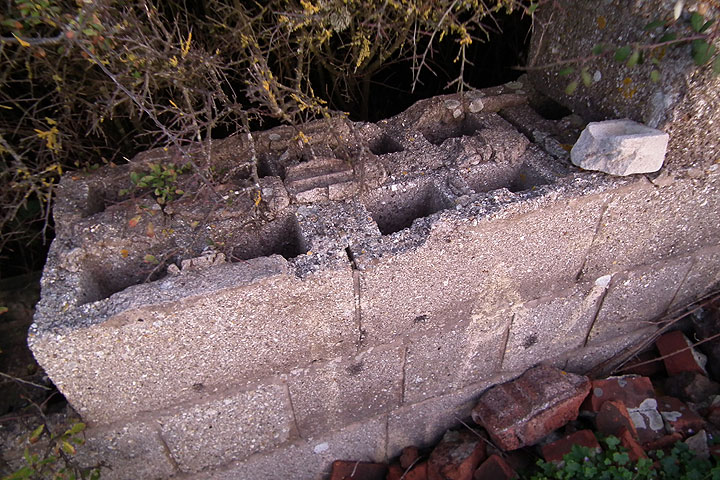
The documents serve to tell us why these walls are crumbling; the shortage of labour and manpower meant that these structures were actually built by the gunners manning the battery.
The reconstruction had actually been tabled in April 1943, but the usual army efficiency, paperwork and u-turns prevented any progress. Then came the order that reconstruction would be undertaken by unit labour:
Action was taken at once to train men from each site in the building work, this was done by sending them for tuition to (batteries in a neighbouring sector) already being rebuilt...
A bulldozer was acquired and two gun emplacements at each battery were razed to clear the ground for reconstruction. It wasn't until mid-December 1943 that the first concrete breeze block had been delivered though; by New Year's Day, only enough blocks to construct two of the bulldozed emplacements had arrived. The end of January saw an improvement in supply. Nearly 47,000 blocks had been delivered, but only because the Anti-Aircraft Brigade in the area had assisted with transport and actually sent gunners to help manufacture the blocks.
By the end of February, the Friar's Bay battery had had only had two emplacements rebuilt; it was then that the reconstruction programme was halted as it was felt that an extensive training programme was of greater benefit. However, it seems that the holdfasts were in place and that the remaining two emplacements were constructed.
The documents have (as usual) proved invaluable in charting the history of the Friar's Bay Battery; only a few engagements have been described, but this information has shone some light on some almost anonymous remains in the landscape. And this is just one HAA battery of at least eight just in the Newhaven area - each of these has its own history equally exciting and detailed...
- Pete

Email:
Blog Latest

Bishopstone reveals its pillbox secrets
18 October 2021

Pillbox or Observation Post?
10 June 2020

Uncovering the hidden secrets of a pillbox
8 June 2019

Review of 2018
31 December 2018

Wartime Christmas in East Sussex (2)
24 December 2018
Jargon-buster
War diary
A record of events kept by all units from the point of mobilisation. A diary's contents vary enormously from unit to unit; some give detailed entries by the hour on a daily basis while others merely summarise events on a weekly/monthly basis.
War shelter
Protective shelter in which a coast artillery gun crew are stationed ready for the call to action, hence its close proximity to the gun emplacement.
This site is copyright © Peter Hibbs 2006 - 2024. All rights reserved.
Hibbs, Peter Tip and Run raids and HAA Battery NH7 (2024) Available at: http://pillbox.org.uk/blog/216688/ Accessed: 27 July 2024
The information on this website is intended solely to describe the ongoing research activity of The Defence of East Sussex Project; it is not comprehensive or properly presented. It is therefore NOT suitable as a basis for producing derivative works or surveys!